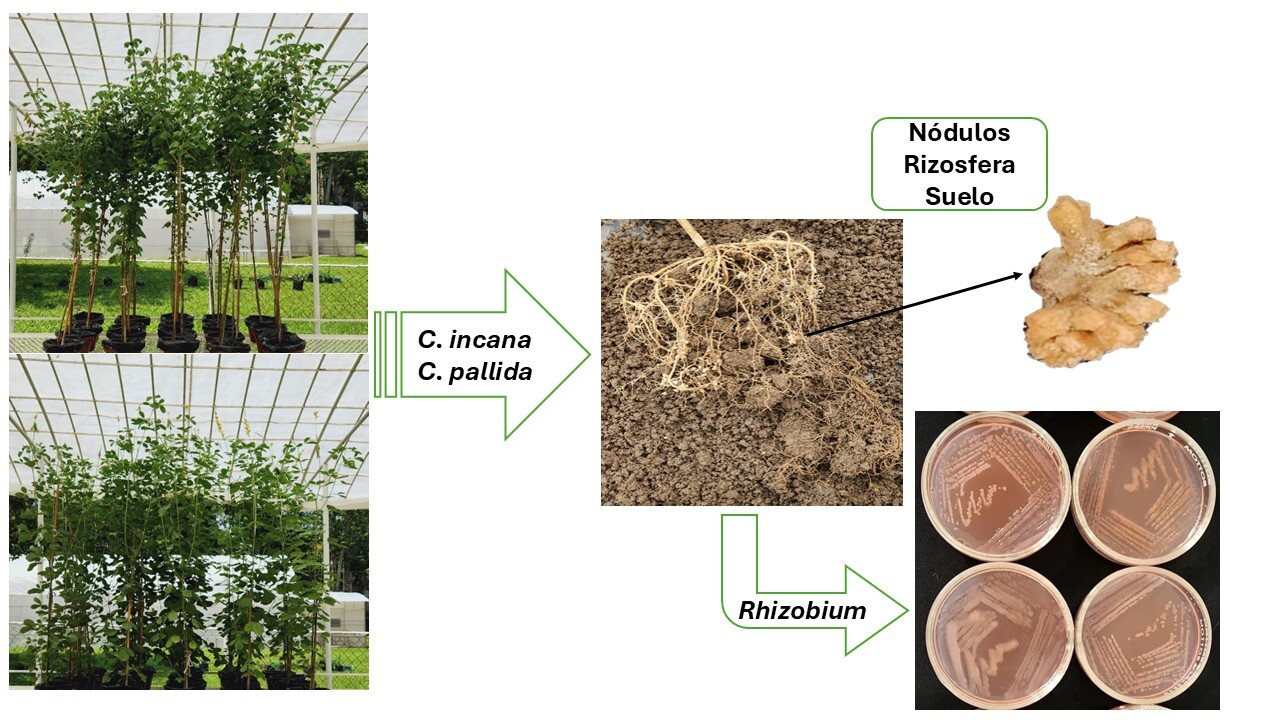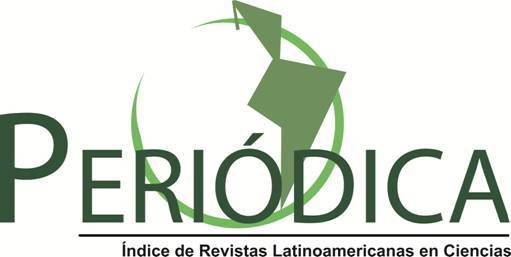Crotalaria-Rhizobium symbiosis as remediators of crude oil pollution
DOI:
https://doi.org/10.18633/biotecnia.v27.2478Keywords:
Legumes, Total petroleum hydrocarbons, Nodules, RhizosphereAbstract
The objective of this research was to identify variables of
growth, production and microbial symbiotic activity in
Crotalaria incana and Crotalaria pallida that, in response to
the stress caused by crude petroleum oil, manage to remove total petroleum hydrocarbons (TPH) from the soil and can be recommended as basic tools in biological technologies for the recovery of degraded soils in the Mexican humid tropics. Crotalaria species were subjected to induced crude petroleum oil contamination at doses of 3, 15, 30, and 45 g/kg in soil and a control treatment at 30 and 154 d of exposure. The results showed statistically significant differences (Duncan p ≤ 0.05) in the growth of the two legumes, with both species being tolerant. The increase in petroleum doses caused negative effects on dry matter production of C. incana and C. pallida. Colonization by Rhizobium spp. was stimulated by crude oil in soil and rhizosphere in both species. However, at day 154, the highest rates of TPH removal were induced at doses of 30 and 45 g/kg, respectively.
Downloads
References
Ahmed, S., Kumari, K. and Singh, D. 2024. Different strategies and bio-removal mechanisms of pe-troleum hydrocarbons from contaminated sites. Arab Gulf Journal of Scientific Research 42(2): 342-358. DOI: 10.1108/AGJSR-09-2022-0172
Allito, B.B., Ewusi-Mensah, N., Logah, V. and Hunegnaw, D.K. 2021. Legume-rhizobium specificity effect on nodulation, biomass production and partitioning of faba bean (Vicia faba L.). Scientific Reports 11: 3678. DOI: 10.1038/s41598-021-83235-8
Ancona, V., Rascio, I., Aimola, G., Caracciolo, A.B., Grenni, P., Uricchio, V.F. and Borello, D. 2022. Plant-assisted bioremediation: Soil recovery and energy from biomass. In: Pandey V.C. (Ed.). 2022. Assisted Phytoremediation (pp. 25-47). Elsevier. DOI: 10.1016/B978-0-12-822893-7.00012-4
Balasubramaniyam, A. 2015. The influence of plants in the remediation of petroleum hydrocar-bon-contaminated sites. Pharm. Anal. Chem. Open Access 1(1): 1000105. DOI: 10.4172/paco.1000105
Bellout, Y., Khelif, L., Guivarch, A., Haouche, L., Djebbar, R., Carol, P. and Abrous, B.O. 2016. Impact of edaphic hydrocarbon pollution on the morphology and physiology of pea roots (Pisum sativum L.). Applied Ecology And Environmental Research 14(2): 511-525. DOI: 10.15666/aeer/1402_511525
Brzeszcz, J., Steliga, T., Ryszka, P., Kaszycki, P. and Kapusta, P. 2024. Bacteria degrading both n alkanes and aromatic hydrocarbons are prevalent in soils. Environmental Science and Pollution Research. 31: 5668-5683. DOI: 10.1007/s11356-023-31405-8
Chaulagain, D. and Frugoli, J. 2021. The regulation of nodule number in legumes is a balance of three signal transduction pathways. Int. J. Mol. Sci. 22: 1117. DOI: 10.3390/ijms22031117
CIAT (Centro Internacional de Agricultura Tropical). 1988. Simbiosis Leguminosa-Rizobio; manual de métodos de evaluación, selección y manejo agronómico. Ed. rev. Proyecto CIAT-UNDP de evaluación, selección y manejo de la simbiosis leguminosa-rizobio para aumentar la fijación de nitrógeno. Sección de Microbiología de suelos del programa de Frijol (comps.). Cali, Colombia. 178 p.
Defez, R., Andreozzi, A., Dickinson, M., Charlton, A., Tadini, L., Pesaresi, P. and Bianco, C. 2017. Improved drought stress response in alfalfa plants nodulated by an IAA over-producing Rhizo-bium Strain. Front. Microbiol. 8: 2466. DOI: 10.3389/fmicb.2017.02466
DOF (Diario Oficial de la Federación). 2002. Norma Oficial Mexicana NOM-021-RECNAT-2000, Que establece las especificaciones de fertilidad, salinidad y clasificación de suelo. Estudio, muestreo y análisis. Martes 31 de diciembre de 2002. 85 p.
Downie, J.A. 2010. The roles of extracellular proteins, polysaccharides and signals in the interactions of rhizobiawith legume roots. FEMS Microbiol Rev. 34: 150-170. DOI: 10.1111/j.1574-6976.2009.00205.x
Ferguson, B.J., Mens, C., Hastwell, A.H., Zhang, M., Su, H., Jones, C.H., Chu, X. and Gresshoff, P.M. 2019. Legume nodulation: The host controls the party. Plant Cell Environ. 42: 41-51. DOI: 10.1111/pce.13348
Gautrat, P., Laffont, C., Frugier, F. and Ruffel, S. 2021. Nitrogen systemic signaling: from symbiotic nodulation to root acquisition. Trends in Plant Science 26(4): 392-406. DOI: 10.1016/j.tplants.2020.11.009
He, M., Li, Z. and Mei, P. 2022. Root exudate glycine synergistically promotes phytoremediation of petroleum-contaminated soil. Front. Environ. Sci. 10: 1033989. DOI: 10.3389/fenvs.2022.1033989
Ikeura, H., Kawasaki, Y., Kaimi, E., Nishiwaki, J., Noborio, K. and Tamaki, M. 2016. Screening of plants for phytoremediation of oilcontaminated soil, International Journal of Phytoremediation 18(5): 460-466. DOI: 10.1080/15226514.2015.1115957
Inckot, R.C., Santos, G. de O., de Souza, L.A. and Bona, C. 2011. Germination and development of Mimosa pilulifera in petroleum-contaminated soil and bioremediated soil. Flora-Morphology, Distribution, Functional Ecology of Plants 206(3): 261-266. DOI: 10.1016/j.flora.2010.09.005
Kang, Y., Li, M., Sinharoy, S. and Verdier, J. 2016. A snapshot of functional genetic studies in Medicago truncatula. Front. Plant Sci. 7: 1175. DOI: 10.3389/fpls.2016.01175
Kekere, O., Ikhajiagbe, B. and Apela, B.R. 2011. Effects of crude petroleum oil on the germination, growth and yield of Vigna unguiculata Walp L. Journal of Agriculture and Biological Sciences 2(6):158-165.
Kovaleva, E.I., Trofimov, S.Y. and Shoba, S.A. 2022. The Response of higher plants to the oil con-tamination of soils in a pot experiment. Moscow University Soil Science Bulletin 77(3): 178-187. DOI: 10.3103/S0147687422030073
Kusar, S., Saddiqe, Z., Ali, F., Bashir, S. and Zubairi, T. 2024. GCMS and HPLC profiling, antioxidant and anti-inflammatory activities of Crotalaria medicaginea Lamk. South African Journal of Botany 168: 196-208. DOI: 10.1016/j.sajb.2024.03.014
Lin, J., Frank, M., and Reid, D. 2020. No home without hormones: How plant hormones control legume nodule organogenesis. Plant Comm. 1: 100104. DOI: 10.1016/j.xplc.2020.100104
López, L.H., Beltrán, B.M., Ochoa, F.Y.M., Castro, A.F., Cerna, C.E. y Delgado, O.J.C. 2022. Potencial agroecológico de Crotalaria spp. como extracto vegetal en la agricultura. Rev. Fac. Agron., La Plata 121(2): 1-16. DOI: 10.24215/16699513e112
Madigan, M.T., Martinki, J.M., Bender, K.S., Buckley, D.H. y Stahl, D.A. 2015. Brock Biología de los microorganismos. 14ª edición. Pearson Educación. Madrid, España. 1099 p.
Mathesius, U. 2022. Are legumes different? Origins and consequences of evolving nitrogen fixing symbioses. Journal of Plant Physiology 276: 153765. DOI: 10.1016/j.jplph.2022.153765
Merkl, N., Schultze-Kraft, R. and Infante, C. 2005. Assessment of tropical grasses and legumes for phytoremediation of petroleum-contaminated soils. Water, Air, and Soil Pollution 165: 195-209. DOI: 10.1007/s11270-005-4979-y
Neumann, G. and Ludewing, U. 2023. Rhizosphere chemistry influencing plant nutrition. In: Rengel, Z., Cakmak, I. and White, P.J. (Eds.). Marschner’s Mineral Nutrition of Plants. Academic Press. Fourth Edition. United Kingdom. pp. 545-585. DOI: 10.1016/B978-0-12-819773-8.00013-7
Orocio-Carrillo, J.A., Rivera-Cruz, M. del C., Aranda-Ibañez, E.M., Trujillo-Narcía, A., Hernán-dez-Galvez, G. and Mendoza-López, M.R. 2019. Hormesis under oil-induced stress in Leersia hexandra Sw. used as phytoremediator in clay soils of the Mexican humid tropic. Ecotoxicology 28: 1063-1074. DOI: 10.1007/s10646-019-02106-1
Osadebe, A.U. and Chukwu, C.B. 2023. Degradation properties of Rhizobium petrolearium on different concentrations of crude oil and its derivative fuels. Environmental and Experimental Biology 21: 83-92. DOI: 10.22364/eeb.21.10
Pourbabaee, A.A., Khazaei, M., Alikhani, H.A. and Emami, S. 2021. Root nodulation of alfalfa by Ensifer meliloti in petroleum contaminated soil. Rhizosphere 17: 100305. DOI: 10.1016/j.rhisph.2021.100305
Rahayu, Y.S., Yuliani, Y., Trimulyono, G., Ratnasari, E. and Dewi, S.K. 2018. Role of nitrogen and phosphate dinamics to increase plant survival grown on oil contaminated soil. IOP Conf. Series: Materials Science and Engineering 434: 012122. DOI:10.1088/1757-899X/434/1/012122
Rai, K.K., Pandey, N., Meena, R.P. and Rai, S.P. 2021. Biotechnological strategies for enhancing heavy metal tolerance in neglected and underutilized legume crops: A comprehensive review. Ecotox-icology and Environmental Safety. DOI: 10.1016/j.ecoenv.2020.111750
Rech, C., Ribeiro, L.P., Bento, J.M.S., Pott, C.A. and Nardi, C. 2024. Monocrotaline presence in the Crotalaria (Fabaceae) plant genus and its influence on arthropods in agroecosystems. Brazilian Journal of Biology 84: e256916. DOI: 10.1590/1519-6984.256916
Riskuwa-Shehu, M.L., Ijah, U.J.J., Manga, S.B. and Bilbis, L.S. 2017. Evaluation of the use of legumes for biodegradation of petroleum hydrocarbons in soil. Int. J. Environ. Sci. Technol. 14: 2205-2214. DOI: 10.1007/s13762-017-1303-5
Rodríguez-Uribe, M.L., Peña-Cabriales, J.J., Rivera-Cruz, M. del C. and Délano-Frier, J.P. 2021. Native bacteria isolated from weathered petroleum oil-contaminated soils in Tabasco, Mexico, accelerate the degradation petroleum hydrocarbons in saline soil microcosms. Envi-ronmental Technology & Innovation 23: 101781. DOI: 10.1016/j.eti.2021.101781
Roy, S., Liu, W., Nandety, R.S., Crook, A., Mysore, K.S., Pislariu, C.I., Frugoli, J., Dickstein, R. and Udvardi, M.K. 2020. Celebrating 20 years of genetic discoveries in legume nodulation and symbiotic nitrogen fixation. The Plant Cell 32: 15-41. DOI: 10.1105/tpc.19.00279
Rusin, M., Gospodarek, J. and Nadgórska-Socha, A. 2015. The effect of petroleum-derived substances on the growth and chemical composition of Vicia faba L. Pol. J. Environ. Stud. 24(5): 2157-2166. DOI: 10.15244/pjoes/41378
Saboon, Bibi, Y., Arshad, M., Ahmad, N., Riaz, I. and Chaudhari, S.K. 2015. An insight into medicinal and ethnopharmacological potential of Crotalaria burhia. Asian Pacific Journal of Tropical Disease 5(7): 511-514. DOI: 10.1016/s2222-1808(15)60826-x
SAS (Statiscal Analysis Systems). 2005. User's guide, versión 9.1.3. SAS Institute, Inc. Cary, NC. 664 p.
Scupinari, T., Mannochio, R.H., Sabino, F.A.B., da Silva, B.V., Pereira, D.W., de Oliveira, N.E., Hoffman-Campo, C.B. and Zeraik, M.L. 2020. Crotalaria spectabilis as a source of pyrrolizidine alkaloids and phenolic compounds: HPLC-MS/MS dereplication and monocrotaline quantifica-tion of seed and leaf extracts. Phytochemical Analysis 31: 747-755. DOI: 10.1002/pca.2938
Sprent, J.I., Ardley, J. and James, E.K. 2017. Biogeography of nodulated legumes and their nitro-gen-fixing symbionts. New Phytologist 215: 40-56. DOI: 10.1111/nph.14474
Terek, O., Lapshyna, O., Velychko, O., Bunyo, L. and Dovgaiuk-Semeniuk, M. 2015. Crude oil con-tamination and plants. Journal of Central European Green Innovation 3(2): 175-184. DOI: 10.22004/ag.econ.206656
Turan, V., Schröder, P., Bilen, S., Insam, H. and Fernández-Delgado, J.M. 2019. Co-inoculation efect of Rhizobium and Achillea millefolium L. oil extracts on growth of common bean (Phaseolus vulgaris L.) and soil microbial-chemical properties. Scientific Reports Nature Research 9: 15178. DOI: 10.1038/s41598-019-51587-x
Uche, E.C. and Dadrasnia, A. 2017. HC-0B-06: Biodegradation of hydrocarbons. In: Heimann K., Karthikeyan O.P. and Muthu S.S. (Eds.). 2022. Biodegradation and bioconversión of hydrocar-bons (pp. 105-135). Springer. DOI: 10.1007/978-981-10-0201-4
USEPA-3540C. 1996. Soxhlet extraction organics. SW-846 test methods for evaluating solid waste physical/chemical methods. http://www.epa.gov/wastes/hazard/testmethods/sw846/pdfs/3540c.pdf
Xie, W., Li, R., Li, X., Liu, P., Yang, H., Wu, T. and Zhang, Y. 2018. Different responses to soil pe-troleum contamination in monocultured and mixed plant systems. Ecotoxicology and Environ-mental Safety 161: 763-768. DOI: 10.1016/j.ecoenv.2018.06.053
Yaqub, M.S., Basher, B. and Aslam, R. 2020. Secondary metabolites of the genus Crotalaria (rattle-pods) and their medicinal importance-A review. Journal of Horticultural Science and Technology 3(1): 1-7. DOI: 10.46653/jhst20030101
Zhang, X., Li, B., Wang, H., Sui, X., Ma, X., Hong, Q. and Jiang, R. 2012. Rhizobium petrolearium sp. nov., isolated from oil-contaminated soil. International Journal of Systematic and Evolutionary Microbiology 62: 1871-1876. DOI: 10.1099/ijs.0.026880-0
Zuzolo, D., Guarino, C., Tartaglia, M. and Sciarrillo, R. 2021. Plant-Soil-Microbiota combination for the removal of Total Petroleum Hydrocarbons (TPH): An in-field experiment. Front. Microbiol. 11: 621581. DOI: 10.3389/fmicb.2020.621581

Downloads
Published
How to Cite
Issue
Section
License
Copyright (c) 2025

This work is licensed under a Creative Commons Attribution-NonCommercial-ShareAlike 4.0 International License.
The journal Biotecnia is licensed under the Attribution-NonCommercial-ShareAlike 4.0 International (CC BY-NC-SA 4.0) license.
















_(2).jpg)







